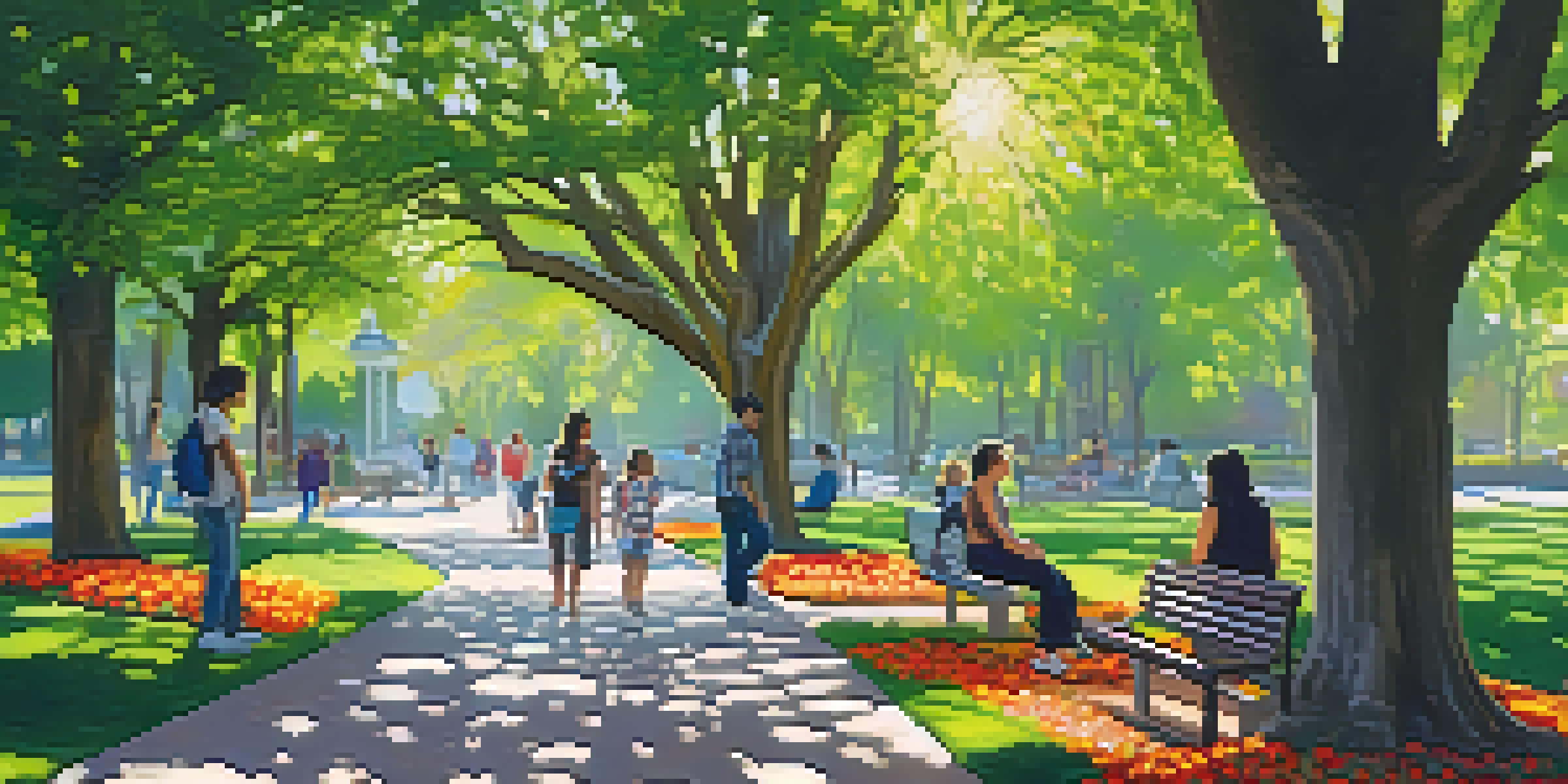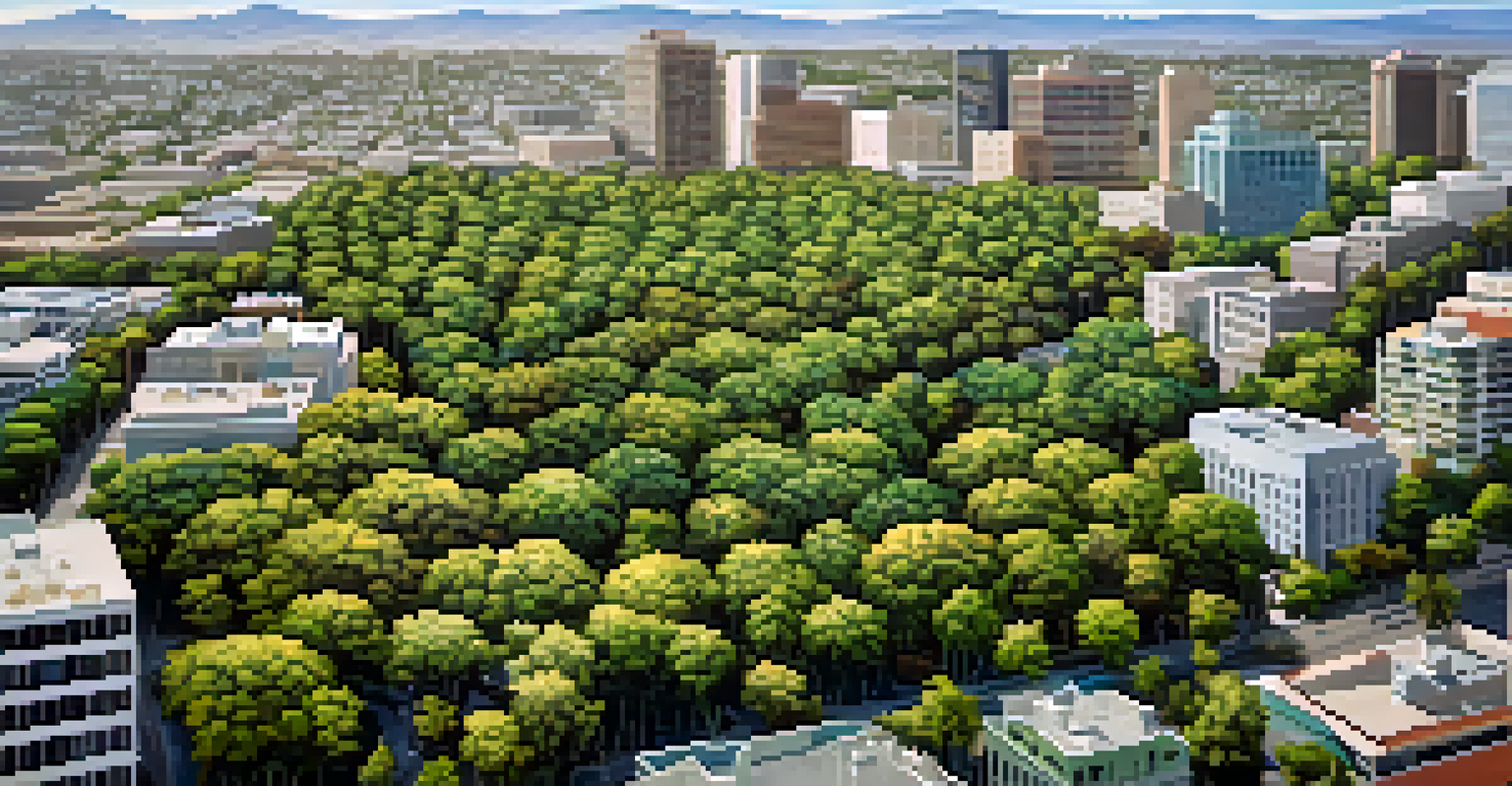San Jose's Urban Forest: Benefits and Management Practices

What is San Jose's Urban Forest and Its Importance?
San Jose's urban forest consists of all the trees in the city, both public and private. This green canopy plays a critical role in enhancing the urban environment by improving air quality, providing shade, and supporting biodiversity. Think of it as the city's lungs, filtering pollutants and releasing oxygen, which is especially important in densely populated areas.
The best time to plant a tree was twenty years ago. The second best time is now.
Beyond aesthetics, urban trees contribute to mental well-being by creating inviting spaces for residents. The calming effect of greenery can reduce stress levels and encourage outdoor activities, fostering a sense of community. Just imagine walking through a park filled with lush trees; it instantly lifts your mood.
Moreover, urban forests help combat climate change by absorbing carbon dioxide. They serve as natural air conditioners, lowering temperatures in urban heat islands, making cities more livable. This multifaceted importance highlights why managing and preserving San Jose's urban forest is essential.
The Environmental Benefits of Urban Forests
Urban forests are vital in managing stormwater runoff, which can lead to flooding and water pollution. Trees absorb rainwater, allowing it to slowly seep into the ground, which reduces the burden on drainage systems. This natural filtration process also helps in purifying groundwater.

In addition to stormwater management, urban forests improve local biodiversity. Trees provide habitats for various wildlife, from birds to beneficial insects, creating a thriving ecosystem within the city. This interaction between urban trees and wildlife underlines the interconnectedness of city life.
Urban Forests Enhance City Life
San Jose's urban forest improves air quality, provides shade, and promotes mental well-being for residents.
Furthermore, urban forests can enhance property values. Homes surrounded by trees typically fetch higher prices due to the perceived benefits of living near green spaces. This financial incentive encourages communities to invest in tree planting and maintenance, fostering a culture of stewardship.
Social Benefits of San Jose's Urban Forest
Trees in urban settings promote social interaction by creating spaces where people can gather and connect. Parks and tree-lined streets become communal hubs, where families can play and neighbors can chat. These shared experiences strengthen community ties and enhance overall quality of life.
In every walk with nature, one receives far more than he seeks.
Additionally, urban forests can play a role in public health by encouraging physical activity. Tree-shaded areas provide inviting environments for walking, jogging, or cycling, motivating residents to stay active. This simple access to nature can lead to a healthier lifestyle for San Jose's residents.
Anecdotally, many people express a stronger attachment to their neighborhoods when they see trees thriving. This emotional connection can inspire residents to engage in local initiatives, further promoting community pride and environmental responsibility.
Challenges Facing San Jose's Urban Forest
Despite its many benefits, San Jose's urban forest faces significant challenges. Urban development often leads to tree removal, which can reduce the overall canopy cover and disrupt the ecosystem. Balancing growth and sustainability is a critical issue for city planners and residents alike.
Invasive species also pose a threat to the health of urban forests. These non-native plants can outcompete native species for resources, leading to a decline in biodiversity. It's essential for city officials and community members to work together in identifying and managing these invasive threats.
Community Involvement is Key
Engaging residents in tree planting and maintenance fosters a sense of ownership and enhances community bonds.
Climate change is another pressing concern, as shifting weather patterns can affect tree growth and health. Increased temperatures, droughts, and storms can stress urban trees, leading to higher mortality rates. This underscores the need for adaptive management practices to ensure the resilience of San Jose's urban forest.
Management Practices for Urban Forest Sustainability
Effective management practices are crucial for maintaining San Jose's urban forest. This includes regular tree assessments to monitor health and growth, ensuring that any necessary care, like pruning or pest control, is undertaken promptly. Such proactive measures can extend the lifespan of urban trees.
Community involvement plays a significant role in urban forest management. Programs that encourage residents to participate in tree planting and maintenance foster a sense of ownership and responsibility. For instance, volunteer days for tree planting not only enhance the forest but also strengthen community bonds.
Moreover, implementing educational initiatives about the importance of urban trees can help raise awareness. Workshops and outreach programs can empower residents to care for their local environment, promoting a culture of sustainability that benefits everyone.
The Role of Technology in Urban Forest Management
Technology is increasingly playing a role in urban forest management. Geographic Information Systems (GIS) can help map tree locations and assess canopy cover, providing valuable data for city planners. This data-driven approach allows for more strategic decision-making regarding tree planting and care.
Mobile apps have also emerged, enabling residents to report tree health issues or provide feedback on local green spaces. This crowdsourced information can aid city officials in prioritizing maintenance efforts and addressing community concerns effectively. Essentially, technology bridges the gap between residents and city management.
Technology Supports Tree Management
Innovative tools like GIS and drones streamline urban forest management, ensuring trees are healthy and well-maintained.
Furthermore, drone technology can assist in monitoring large areas of urban forest quickly and efficiently. Drones can capture aerial imagery to assess tree health or identify areas needing attention, making the management process more efficient and responsive.
Community Initiatives Supporting Urban Forest Growth
Numerous community initiatives are underway in San Jose to support urban forest growth. Local nonprofits often organize tree planting events, encouraging residents to come together and contribute to the city's green canopy. These events not only increase tree numbers but also educate participants on the importance of urban forests.
Schools are also getting involved by integrating environmental education into their curricula. Students participate in tree planting projects, learning firsthand about ecology and the significance of trees in their community. This hands-on approach fosters a new generation of environmentally conscious citizens.

Additionally, partnerships between the city and local organizations can lead to more comprehensive urban forest management plans. Such collaborations can pool resources and expertise, ensuring that San Jose's urban forest continues to thrive for future generations.